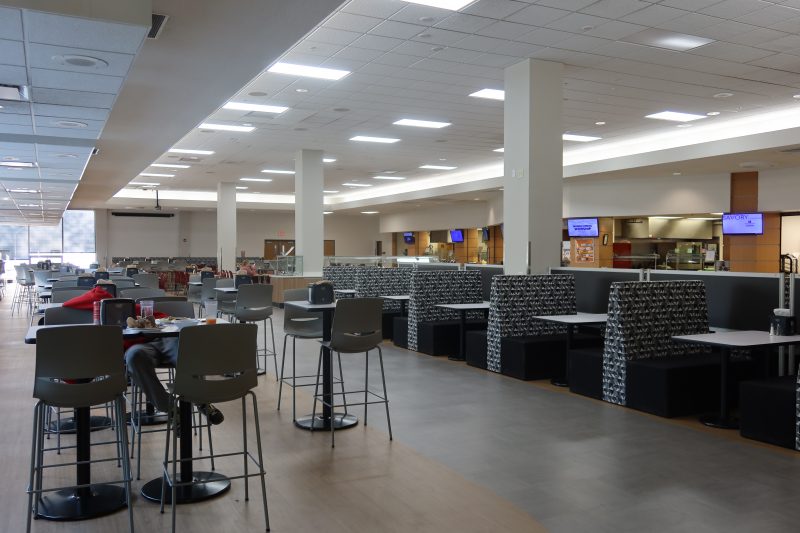By Diego Setton — Saturday, October 5, the remaining new furniture at Morningside’s Cafeteria (or caf), was installed, marking the end of the first phase of the planned renovation project.
Earlier this year, it was announced to students and faculty alike that Morningside had renewed its contract with Sodexo, and that the Wikert Dining Hall and The Mustang Grill would both be fully renovated.
Construction was scheduled to take place during the summer, and it was expected to be fully completed by the end of July just as the first students would be coming back to campus.
As most of us are aware, this didn’t come into fruition. On July 31, an email sent by President Albert Mosley announced there had been significant delays to the project.

As of right now, it seems the first half of the renovation schedule has been completed; however, the full renovation plans are now scheduled to conclude in fall 2025.
Recently, I got to interview President Mosley and had a chance to ask about the delays; here’s what I learned:
CR: Why change it in the first place?
Mosley: Our food service contract with Sodexo recently came up for renewal, which provided us an opportunity to enhance our partnership. As is common with contract renewals, we aimed to incorporate some innovations to improve the space. Sodexo remains our food provider and has agreed to a modest refresh of the area, rather than a full renovation. We felt it was an ideal time for a makeover to update the space and enhance the overall experience.
CR: In the email it was briefly mentioned that the project faced significant challenges when trying to secure contractors, furniture and the necessary permits. Could you provide a little more information about what exactly happened to cause these delays?
Mosley: While Morningside had the opportunity to influence the design and direction of the project, the execution was ultimately handled by Sodexo. It’s crucial to remember that Sodexo operates as a separate entity with its own best practices. Some of the delays encountered during the project were due to ongoing supply chain challenges, which were beyond anyone’s control. Additionally, Sodexo’s practice involves using external contractors, and our project was one of their smaller commitments. Large companies often face unique challenges when operating in smaller cities like Sioux City, where certain limitations can impact project progress.
CR: So, why was the decision to go to these external contractors made?
Mosley: Again, Sodexo is an international corporation with a number of divisions. We have an agreement with their catering and food services business unit, and by signing on with them we also agree to follow their business practices and work with their various divisions and vendors. Had this been a Morningside project, we would have used local vendors who we are familiar with and may have been able to tap leverage their connections differently. Instead, we were relying on Sodexo’s processes and resources.
CR: If the previously mentioned steps hadn’t yet been secured, why not wait a bit to fully announce the project? Why was it announced at the date it was?
Mosley: At the time of the announcement in April or May, Sodexo’s construction unit provided a detailed construction schedule, which we approved. We expected everything to proceed according to plan and made the announcement based on that belief. Unfortunately, the project faced some unforeseen challenges, and things did not go as anticipated. Despite the obstacles, our decision to make the announcement was based on the information available at that time, with the expectation that the project would be completed by August 1.
CR: What was your reaction when the news about the delay reached you? I imagine you weren’t exactly happy to send out that email?
Mosley: I never like to disappoint our students. Our initial excitement about the renovation announcement stemmed from the belief that it would enhance the student experience significantly. The dining space is integral to campus life; it’s not only about the quality of food but also about the ambiance and aesthetics. It’s a place for you to take a break, fellowship, and be nourished. The delays meant we aren’t able to immediately provide students with the dining environment they deserve, and I was particularly disheartened by the necessity of temporary furniture, which is uncomfortable and unappealing. As someone who dines there frequently, I find the interim setup not reflective of the standards we intended to achieve. At the same time, I also understand that Sodexo found themselves facing unexpected challenges and did their best to mitigate the situation – though like everyone else, I am anxious for the entire project to be completed.
CR: Why was splitting the projects by parts the chosen solution? Were there other options available?
Mosley: By the time the realities of the project became clear at the end of June, we were facing a deadline of Aug. 1 necessitated by the return of our fall athletes. The dining space had to be ready to accommodate those students regardless of what was happening with the project. We opted to split the renovation into phases to minimize disruption for our students, with the first milestone being to provide an operational dining space by Aug. 1 for our fall athletes. The second phase is scheduled for the winter break, a time when the cafeteria is typically closed, so it should not impact students. The last phase will happen next summer. Again, it was not ideal, but the phased approach was essential to ensure that our students’ dining needs were met with minimal inconvenience.
CR: Is there anything else you would like to add?
Mosley: I’ll be the first to acknowledge that the current appearance falls short of the inviting warmth we intended to achieve, and I have concerns about its potential impact on our students’ overall experience. Creating an environment that aligns with our community standards and enhances campus life is a top priority. Simultaneously, keeping the dining facility operational is crucial as it plays an essential role in daily student life. Though the phased approach and the current state of the Cafeteria are not ideal, I am committed to collaborating with our partners at Sodexo to ensure the project’s success in future phases. Our ultimate goal is to provide a dining environment that truly meets the long-term needs and expectations of our students.
So far, it’s been great to see that the first phase of the renovation plan announced by President Mosley in July has been completed in time. We hope that the next two phases can run just as smoothly and that soon students, faculty, and staff will be able to enjoy a fully renovated and refurbished cafeteria.








Leave a Reply